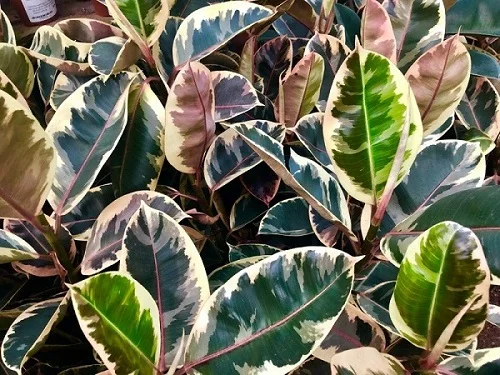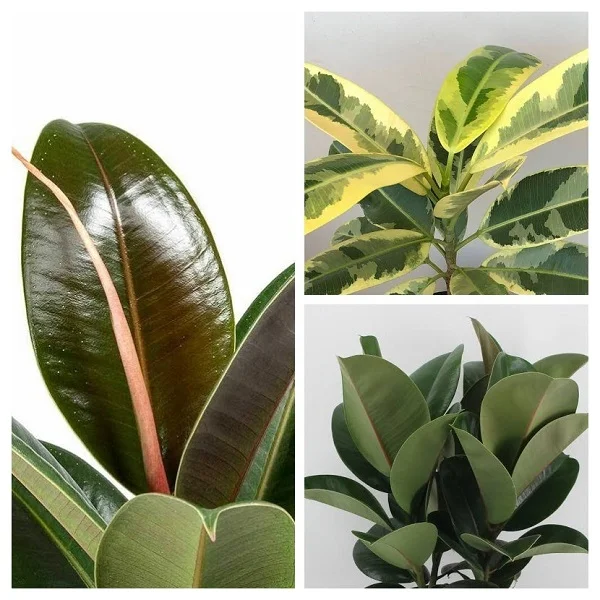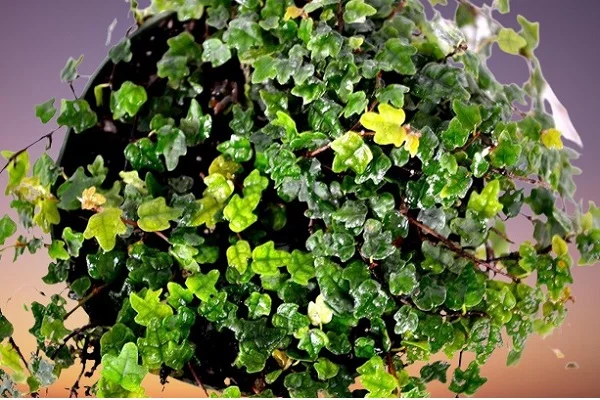Ficus montana (Oak Leaf Fig) Indoor Care, Propagation, Common Problems and Remedies
Some links in this post may be affiliate links
Ficus montana (Oak Leaf Fig) requires bright light with some direct sunlight, warm and humid conditions and moderately moist, rich, well-drained soil coupled with monthly feeding during the growing season.
Ficus montana also called Oak-leafed Fig is one of the vining Ficus varieties and bears oval-shaped leaves, covered with short hairs in form of bristles and resemble oak leaves.
The leaves on new growth are brown-green but they turn green as they mature. Oak-leafed Fig is a crawling plant like Creeping Fig (Ficus pumila) both of which are ideal groundcovers as they develop roots at the nodes.
Oak Leaf Fig is often mistaken for Ficus pumila quercifolia, the Oak Leaf Creeping Fig also called Miniature Oakleaf Fig or String of Frogs Plant.
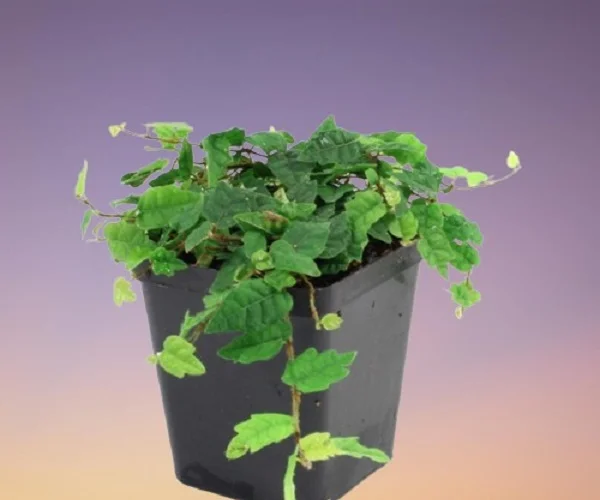
Botanical name: Ficus montana
Family: Moraceae
Common names: Oak Leaf Fig, Oak-leafed Fig
Origin
Ficus montana is native to mountainous regions of South East Asia where it grows along the banks of forest rivers and other water bodies as well as under the shade of stones. The species name, 'montana', means mountains, in reference to where it comes from.
Size
Oak Leaf Fig stems can grow upto 3-6 feet long. The plant is perfect for a hanging basket where the stems can cascade downwards beautifully. It is one of the best plants for a hanging basket.
Is Ficus montana toxic to pets?
Yes. Like other plants in the Moraceae family, Ficus montana is toxic to humans and pets as indicated by Pet Poison Helpline. Ficus plants produces a milky white latex which is an irritant to the eyes and the skin. If ingested it can cause irritation in the mouth, drooling, vomiting, diarrhea, loss of appetite and abdominal pains.
Ficus montana Care Indoors
Care for Ficus montana indoors entails giving it bright light with 4-6 hours of direct sunlight, average warmth of 15-260C, humidity of 60-70% and moderately moist, rich, well-drained soil coupled with monthly feeding in the growing season.
Oak Leaf Fig care involves regular pruning to rejuvenate growth and also encourage a bushy, compact growth. Repotting is only needed when it becomes pot-bound. Keep reading for more on these growing conditions and how to provide them.
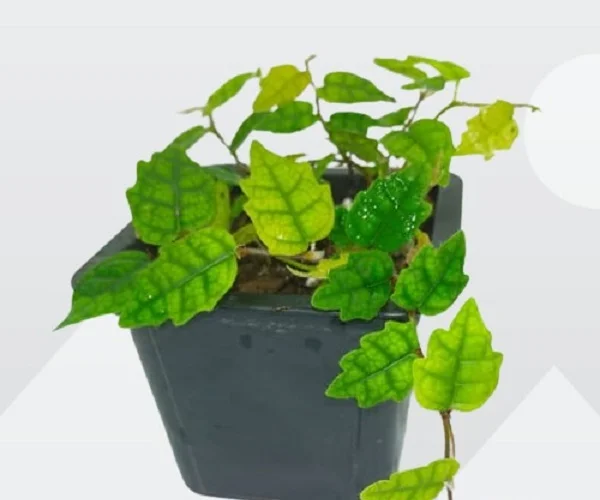
Watering
How often should I water Ficus montana indoors?
To avoid either overwatering or underwatering, do not water Ficus montana on a schedule, as both can be detrimental to its growth.
Water Ficus montana liberally in spring and summer until water comes out through the drainage holes and allow the top 2-3 inches of soil to dry out between waterings. Keep the soil moderately moist and avoid soggy soil to prevent yellowing and rotting.
Decrease watering in fall and winter to maintain the soil barely moist as growth is minimal at this time. Do not let the soil dry out completely to avoid wilting and leaf drop.
Use water that is at room temperature as cold water can shock the plant resulting in reduced growth and leaf drop.
Oak-leafed Fig is sensitive to chlorine and other chemicals dissolved in water. Use only chlorine-free water like rain water or filtered water to avoid leaf spots.
Ensure that the pot has a drainage hole and the soil is well-draining to prevent it from getting soggy as it may result in leaf drop, root-rot and death of the plant.
Light Requirements
Can I grow Ficus montana in low light?
Ficus montana grows best in bright light with at least 4-6 hours of direct morning or late afternoon sunlight. Avoid exposing it to hot midday sunshine as it can cause sunscorch (brown) marks on the leaves and eventual leaf drop.
Oak-leafed Fig can adapt to lower light conditions but it will grow much slower. If light is too little it can result in leggy growth, yellowing and leaf drop. Where the natural lighting is not adequate, you may use a grow light to supplement it.
Turn the pot regularly to ensure that the plant receives light on all sides for even growth and prevent leggy growth.
Temperature and Humidity
Oak-leafed Fig thrives in an average warmth of 15-260C. Keep it away from drafts to prevent sudden changes in temperature as they can cause leaf drop.
Does Ficus montana require high humidity?
Ficus montana requires a humidity of 60-70% to flourish. To raise humidity, set the pot on a wet pebble tray, use a humidifier or group the plants together. Do not mist the plant as it can promote fungal disease infestations.
Fertilizer
Feed Ficus montana with a balanced, water-soluble fertilizer every 3-4 weeks if spring and summer. Too much fertilizer may result in leggy growth.
Do not feed in fall and winter as growth is minimal and feeding at this time can cause fertilizer burn; brown leaf tips and edges.
Every 1-2 months, flush out the accumulated salts from the soil by running a stream of water through the soil until it drains through the drainage holes.
Potting Soil
Oak Leaf Fig potting soil should be a rich, well-draining potting mix to prevent waterlogging while providing nutrients. A blend of 50% peat or coco coir (for moisture retention), 30% perlite (for drainage), and 20% compost or organic matter (for nutrients) is perfect for this plant.
Repotting
Repot Oak Leaf Fig at the beginning of the growing season only when it has become pot-bound. Plants younger than 5 years should be repotted annually.
Thereafter, avoid frequent repotting as it prefers to be pot-bound. Repot only when it has outgrown its current pot; when roots begin to grow through the drainage holes.
Use a pot 1 size larger and one that has a drainage hole to prevent the soil from getting soggy. Never allow the roots to sit in soggy soil as it can result in leaf drop and root-rot. Check out these pots with multi-mesh drainage holes on Amazon.
For a large Ficus montana which may be difficult to handle, annually replenish the top 2-4 inches of soil with fresh soil while taking care not to injure the roots.
Pruning & Maintenance
Pruning Oak Leaf Fig is easy:
- Remove dead and yellow leaves to maintain the plant neat and discourage pest and disease infestations.
- Cutback the branches when the plant has reached maximum growth or has become leggy, to rejuvenate growth and also encourage a bushy, compact growth. The foliage emanating from the pruning can be used to propagate new plants.
Regularly clean the leaves by damp-wiping with a soft cloth to get rid of dust and also discourage pest infestation.
Ficus montana Propagation
Ficus montana (Oak Leaf Fig) is propagated in the beginning of the growing season (spring) from stem cuttings.
Propagating Oak Leaf Fig from stem cuttings
- Take stem cuttings about 6 inches long from a healthy plant.
- Strip off the lower leaves from the cutting and retain 2-3 leaves on top.
- Allow the sap to dry and then dip the lower cut end cutting in a rooting hormone to hasten rooting.
- Fill a rooting container with a well-draining rooting soil and moisten it slightly. Ensure the container has adequate drainage to prevent rotting.
- Insert 2-3 inches of the lower cut end of the cutting in the moist rooting soil.
- To enhance rooting of the cutting, create a mini-greenhouse by covering the set up with a clear polythene bag or sheet.
- Ensure that the leaves do not touch the bag or the sheet too much by propping it up with sticks.
- Place the set up in warm, brightly-lit spot away from direct sunlight.
- Maintain the soil moist through out until rooting occurs which is indicated by new growth; rooting happens in 3-4 weeks.
- Gradually over a period of two weeks, remove the plastic cover to acclimate the new plant to ordinary growing conditions.
- In 4-6 months, there will be adequate growth and you can transplant the new plants into individual pots after which you can begin routine care.
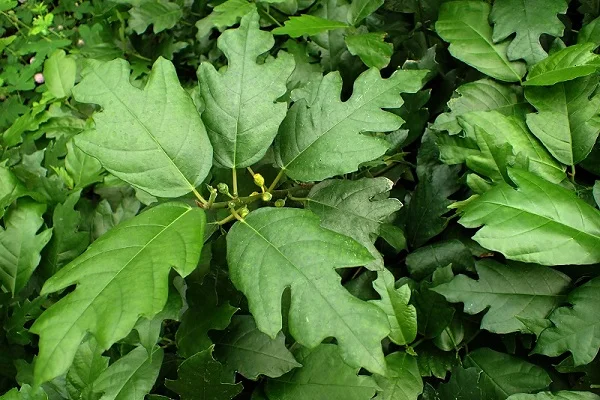
Ficus montana Problems & Remedies
Ficus montana (Oak Leaf Fig) common problems are leaf drop, drooping leaves, yellow leaves, brown leaves, brown leaf edges, pests and diseases among others. Keep reading for more details on these problems and how to fix them.
Leaf drop
Leaf drop on Ficus montana is caused by too little light, inconsistent watering, soggy aoil, drafts and being pot-bound.
How to fix it
Too little light: Position the plant in a brighter spot or use a grow light.
Inconsistent watering: Water when the top 2-3 inches of soil dry out and do not allow the soil to dry completely.
Soggy soil: Use a pot with a drainage hole and well-draining soil.
Drafts: Keep the plant away from drafts coming from heat sources, AC units, windy doors and others to maintain temperatures of 15-260C.
Being pot-bound: Repot the plant into a pot one size larger than the current one.
Related Content: 14 reasons why Rubber Plant is dropping leaves and how to fix them.
Drooping leaves
Drooping leaves on Oak Leaf Fig are due to underwatering, temperature stress, dry air, and spider mites infestation.
How to fix it
Underwatering: Water when the top 2-3 inches of soil dry out but do not allow the soil to dry out completely.
Temperature stress: Keep the plant away from drafts emanating from AC units, heat sources and others to maintain temperatures of 15-260C.
Dry air: Set the pot on a wet pebble tray or use a humidifier to increase humidity. Group the plants together to create a humid microclimate.
Spider mites infestation: Keep the plant well pruned and increase humidity to discourage the pests.
Related Content: 13 Reasons Rubber Plant leaves are drooping & remedies.
Yellowing leaves
Why are my Ficus montana leaves turning yellow?
Some of the causes of yellow leaves on your Ficus montana are dry air, overwatering, soggy soil and aging.
How to fix it
Dry air: Set the pot on a wet pebble tray or use a humidifier or grow the plant in a well-lit bathroom.
Overwatering: Water only when the top 2-3 inches of soil feel dry. Do not water on a schedule.
Soggy soil: Use well-draining soil and a pot that has a drainage hole.
Aging: It is natural for the old leaves to turn yellow and drop as the plant matures.
Brown leaves
Why are the leaves on my Oak Leaf Fig turning brown?
The main causes of brown leaves on your Oak Leaf Fig are inconsistent watering, soggy soil, and extreme temperatures.
How to fix it
Inconsistent watering: Do not water on a schedule. Water when the top 2-3 inches dry out. Never allow the soil to dry out completely.
Soggy soil: Use a pot with a drainage hole and well-draining soil.
Extreme temperatures: Keep the plant away from drafts coming from AC units, drafty windows, heat sources, windy doors and others.
Brown leaf edges
Why are my Ficus montana leaves turning brown at the edges?
Brown leaf edges on your Ficus montana are caused by low humidity, temperature stress and salts buildup.
How to fix it
Low humidity: Use a wet pebble tray or a humidifier to raise humidity. You may grow the plant in a well-lit bathroom and other moist areas in the home.
Temperature stress: Keep the plant away from drafts to maintain an average warmth of 15-260C.
Salts buildup: Flush out the accumulated salts from the soil every 1-2 months by running a stream of water through the soil until it drips through the drainage holes.
Pests
Common pests in Oak Leaf Fig are aphids, mealybugs, scale insects and spider mites.
How to fix it
- Seperate the affected plant to prevent spread to other plants and treat it with neem oil or insecticidal soap as per the manufacturers' recommendations.
- Regularly damp-wipe the leaves with a soft cloth to discourage the pests.
- Keep the plant well pruned to minimize the hiding and breeding places for these pests.
Diseases
Ficus montana is prone to root-rot disease which is enhanced by soggy soil. It is characterized by yellowing and wilting of the leaves which is rapidly followed by browning and plant collapse.
How to fix it
- Carefully slip the plant out of its pot and inspect the roots.
- Trim brown-black, mushy roots and treat the healthy roots with a copper-based fungicidal solution as instructed on the label.
- Disinfect the pot with the fungicidal solution or use a fresh pot to repot the plant in fresh, well-draining soil.
- Do not water the plant immediately and keep it dry for 5-7 days before you can resume watering.
- Use a pot with a drainage hole and well-draining soil at all times to prevent the soil from soggy.
- Reduce on watering in fall and winter as growth is slowed at this time; keep the soil slightly moist.
Conclusion
Ficus montana (Oak Leaf Fig), is a wonderful plant that brings tropical charm to any space. With proper care; adequate light, consistent watering, moderate humidity, and occasional pruning, it will thrive indoors for years. Propagation from stem cuttings allows you to expand your collection, while knowing how to troubleshoot common problems ensures a healthy and vibrant plant.
You liked it? Share on social media.
Related Content
Amazon Associates Disclosure
Homeplantsguide.com is a participant in the Amazon Services LLC Associates Program, an affiliate advertising program designed to provide a means for sites to earn advertising fees by advertising and linking to amazon.com.



